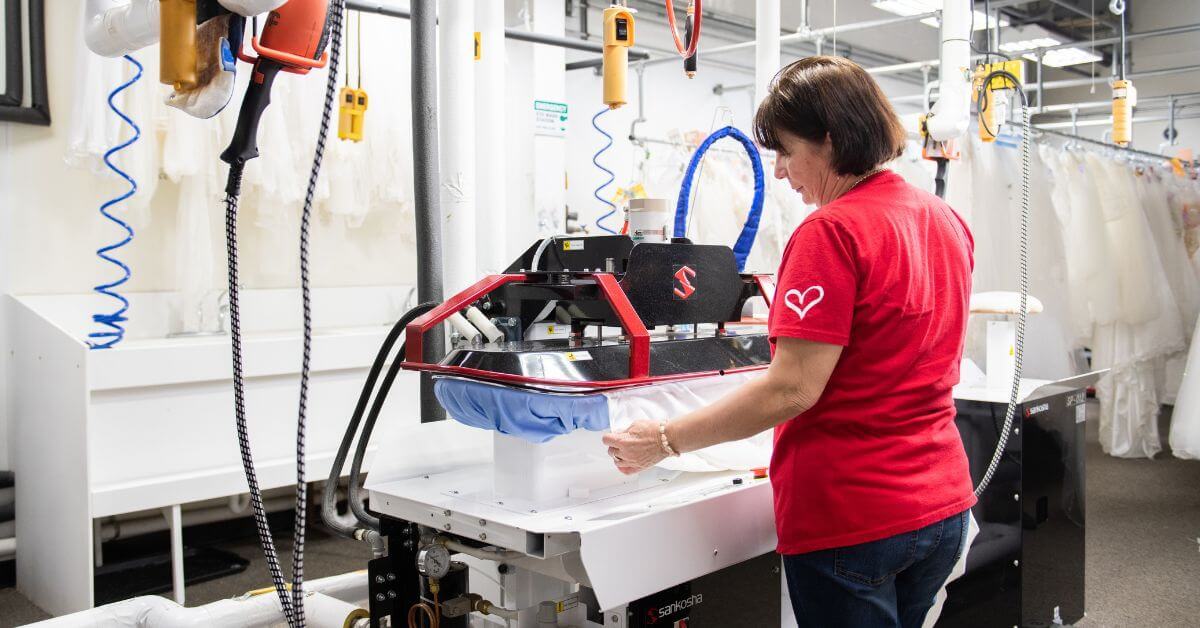To better understand the terms associated with cleaning and preservation of your wedding dress, we have curated a glossary for you. With this guide, you’ll get an insight into specific terminology, methods, products, and tools you might hear when you visit or connect with a preservation expert.
Keep reading to learn more about the terms that will eventually help you make informed decisions about cleaning and preserving your wedding dress.
A
Alkalinity
A specific alkalinity level is required for the products that are used for cleaning and preserving wedding attire. The level of alkalinity determines the effectiveness of the product in removing the stains. Moreover, the fabric's basicity must be considered before picking a detergent for it. Finally, creating this balance requires a lot of hands-on experience and training.
Archival Textile
It is, in simple terms, a fabric that holds cultural and historical significance for a certain group of people or individuals. Besides, these are used to support valuable posters, documents, and maps. They are treated well to avoid yellowing or fraying.
B
Bath
Bathing is the process of immersing a garment in warm or cool water with an active detergent to clean stains and remove discoloration. The soaking duration and the choice of detergent in this method are completely dependent on the fabric and the level of soiling or yellowness.
Beading
This term is used for decorative adornments often found on the wedding gowns. These embellishments are sometimes temporarily removed to prevent damage and ensure proper attire cleaning.
Bleaching
The traditional method of bleaching is especially not suitable for wedding outfits. Thus, the safe and less aggressive alternative for bleach is to use oxidizing agents such as Sodium percarbonate. It removes stains effectively without harming the fabric's quality.
Blotting
Blotting is a gentle technique for removing stains from the fabric. This method requires no rubbing or damage of the material during the whole cleaning process. Instead, pressing the stained area with the gamp blotter works best to lift and remove the marks.
BonGo®
A commercial stain removal method is mainly designed to clean beverage stains such as fruit juices, coffee, tea, and even wine marks. However, the BonGo® method is not recommended for cleaning milk stains.
Bust Form
This piece of equipment is used to maintain the shape and appearance of the dress while it is stored in a display chest. These forms are available in various sizes and are best recommended to use for avoiding creasing or fold marks on the dress if stored for a long period.
C
Conditioning Solution
A simple solvent is used in place of water to clean and process stained fabrics. Perchloroethylene was earlier preferred as the best conditioning agent, but with the evolution of modern preservation techniques, safer and more effective agents have been introduced in the market.
Crinoline
A structured undergarment which is used to give the skirts a bell-shaped silhouette. This underskirt is majorly important to bring a dramatic effect to the attire.
D
Declared Value
This term refers to the original purchase value of the wedding attire, which is essential for determining the outfit's shipping and preservation insurance coverage.
Detailing
Detailing is used for the decorative elements to enhance the wedding gown's beauty. These elements may be in the form of crystals, beading, lace, etc. All the adornments are repaired or replaced if they get lost during cleaning or preservation.
Display Chest
It is a storage display chest made with lignin-free and acid-free materials. It has a UV-protected window for viewing what’s stored in the chest without removing the case. These chests also keep memorabilia from the rest of the wedding day.
Dowels
These are the supportive rods that are used within the display chest to prevent the gown from shifting from its place during transportation. It even maintains the structure of the attire, in the best possible way.
Drip Dry
It is a process that allows the garment to slowly dry on its own without any mechanical assistance. It is a gentler method for delicate and adorned fabrics.
Dry Cleaning
In the dry cleaning method, water and other liquid solvents are not used to bring out the best of your attire. In fact, about 25% of wedding dresses, especially silk ones, undergo the dry cleaning process over regular washing.
E
EasyGo®
It is a biodegradable and non-combustible dry-cleaning stain remover. This chlorinated solvent is exceptionally fantastic for removing organic stains like that of makeup, food, oil, lotions, grease, and more.
Embellishments
This term is used for the decorative elements adorned on the dress, such as lace, beading, ruffled feathers, and more. All these things require special care and attention during the preservation process.
F
Fabric Rot
It is often referred to as dry rot, which mostly occurs when a fabric is left untreated with stains and marks for many years. The stains break down the fibers of the fabric over time, making it impossible to reverse the damage and preserve it for years to come.
Flushing
In simple words, flushing suggests the removal of the cleaning agents from the fabric after the wet processing is complete. It is typically achieved by soaking the fabric and rinsing it multiple times with clean water.
Folex®
The formula of Folex® works great as a spot stain remover from all types of fabrics including the delicate materials of a wedding gown. It mainly treats stains like grease, dirt, red wine, coffee, blood, ink, cosmetics, grime, and even some old stains.
G
Garment Bag
It is a cotton bag to keep your dress temporarily protected during transportation. However, it is not the best option for long-term garment preservation.
H
Hand Cleaning
It is exactly what it says - a gentle method for wet cleaning the wedding dress by hand instead of dry cleaning. 45% of the wedding outfits we receive are hand-cleaned for thorough removal of the stains and yellowishness.
Hand Steaming
The best way to carefully remove the wrinkles from the dress before storing it in the chest. It is a gentler method than machine pressing, as it keeps the adornments intact.
I
Inspection
It is the process of examining the dress for all the stains, yellowing, or missing embellishments after its arrival at the facility for cleaning and preservation. Once inspected, all the delicate areas are given tailored attention.
K
K4
It is an abbreviation used for “SystemK4” cleaning system. It is developed by Kreussler Textile Care of Germany. This method is known to be most effective for removing stains while maintaining the quality of delicate fabrics.
L
Lignin
It is an organic compound found in wood that can cause yellowing in fabrics; display chests should be lignin-free.
Leveling Agent
Used after cleaning to prevent water stains on moisture-sensitive textiles.
M
Main Wash
The cleaning phase addresses general soiling and yellowing after spot treatment.
O
Oil Stains
Caused by food or grease, these stains require specific treatments to avoid permanent marks.
Organic Stains
Stains from natural sources like food or dirt often need specialized treatment.
P
Perchloroethylene
Traditionally used in dry cleaning, though modern alternatives are often preferred for wedding dresses.
Phenolic Yellowing
Discoloration due to a reaction between the dress and certain packaging materials; acid-free storage is essential.
R
Restoration
The process of returning a dress to its original state is often used for older gowns.
RustGo®
A product for removing rust stains from fabric.
S
Spot Clean (Spotting)
Treating specific stains with gentle chemicals to avoid fabric damage.
Shrinkage
There is a risk of a dress shrinking if it is dried too quickly after wet cleaning.
T
Tamping
Gently press cleaning agents into a stain for removal.
Titanium Sulfate
A chemical used to remove unwanted dye.
V
Viewing Window
A UV-coated window on the preservation chest for viewing without exposing the dress to contaminants.
W
Wet Cleaning
A method using water and detergents to treat stains and yellowing; suitable for about 75% of gowns.
Y
YellowGo®
YellowGo® is a powerful cleaning solution used to remove organic stains, such as clay and ink residues, from wedding dresses.
Yellowing
Yellowing is the discoloration that occurs in white or ivory wedding dresses over time, often due to environmental factors. This process, known scientifically as "Phenolic Yellowing," results from a reaction between fabric and nitrogen oxides, highlighting the importance of acid-free and UV-protected storage.
Z
Zout® Fels-Naptha
Zout® Fels-Naptha is a potent laundry bar known for removing greasy or oily stains, as well as perspiration. It's commonly used in pre-spotting and spot cleaning for wedding dress preservation.
Understanding the terminology used in wedding dress preservation helps you make informed decisions and trust the process of preserving your gown for the future.
At DressPreservation.com, our expert team is dedicated to treating each dress with the utmost care. If you want to learn more or start the preservation journey for your cherished gown, visit us today. Preserve your memories with confidence, knowing your gown is in trusted hands.
For a comprehensive overview of the preservation process, explore our Ultimate Guide to Wedding Dress Preservation.







